Change Management: The Key to Successful Digital Transformation
The global COVID-19 pandemic has been a catalyst for major shifts in recent years, and has drastically increased the importance of a critical business process: change management. It’s a key tool for companies that wish to future-proof their services, infrastructure, and relevance. Without it, time and resources are misallocated, and employee development may be sidelined.1 Ultimately, it can even lead to company-wide failure if not done correctly – which is common, as half of all change initiatives fail and only 34% are considered a success.2
An area that sees perhaps the greatest demand for organizational change management is digital transformation, which harnesses technology to create new or optimize existing processes, culture, and customer experiences.3 COVID-19 has drastically increased the need for technology within business and digital transformation – strategic change management is the key to unlocking the effectiveness of both. This is mostly due to the rise in remote working and flexible workplaces, but it’s also because companies are increasingly leveraging digital tools such as artificial intelligence (AI) and blockchain. Global spending on digital transformation is forecast to reach $2.8 trillion in 2025, more than double the amount allocated at the start of the decade.4
Digital transformation is no longer an afterthought of implementing business technology – it’s the first step. It’s a necessary tool for survival in a worst-case scenario, and a source of profit-yielding innovation in the best case. And change management is your secret to digital success. For a brighter, more connected future, leaders will require a bespoke strategy that merges digital with change – and is informed by technology, process workflows and, crucially, people.
GetSmarter recently surveyed 5,808 professionals from 128 countries to examine what digital transformation means for your career. The research highlights a critical incentive for undertaking digital transformation: it can ignite the ability and resilience of organizations and individuals. It reveals that human capital offers both the biggest challenge and the greatest solution to digitally transforming the workplace. The innovation needed can’t be defined solely in technological terms; it has to be human-centered. Resistance to change is one of the main reasons 68% of digital transformations fall short of their goals.5 To avoid this pitfall, an effective change management strategy is vital.
To successfully roll out these change management processes for true digital transformation in your business, you’ll need to approach it in an intelligent, behavior-centered way.6
Start by considering these five Ws:
- Why is there a need for digital transformation?
- What do you need in technology, processes, and management?
- Who is responsible for the execution of the plan?
- When will the changes take place, and what are the milestones?
- Where will these changes occur?
Why do we need digital transformation?
The meteoric rise in online interactions has had a knock-on effect for all industries. Pandemic-induced global lockdowns caused a spectacular growth in remote working, AI, cloud services, online commerce, the Internet of Things (IoT), Software as a Service (SaaS), and new digital tools. Today, savvy organizations are harnessing these technologies to increase customer and employee satisfaction and enable higher-quality user experiences.7
Businesses are being forced to play digital catch-up, and most aren’t succeeding. GetSmarter’s 2022 research reveals that 66% of professionals say a significant amount of disruption has already occurred in their industry in the past year, but only 40% feel their company is currently doing enough to respond. Crucially, the results also indicate that the next two years will still be further disrupted by emerging technologies and COVID-19, ramping up the need for digital transformation across all industries.
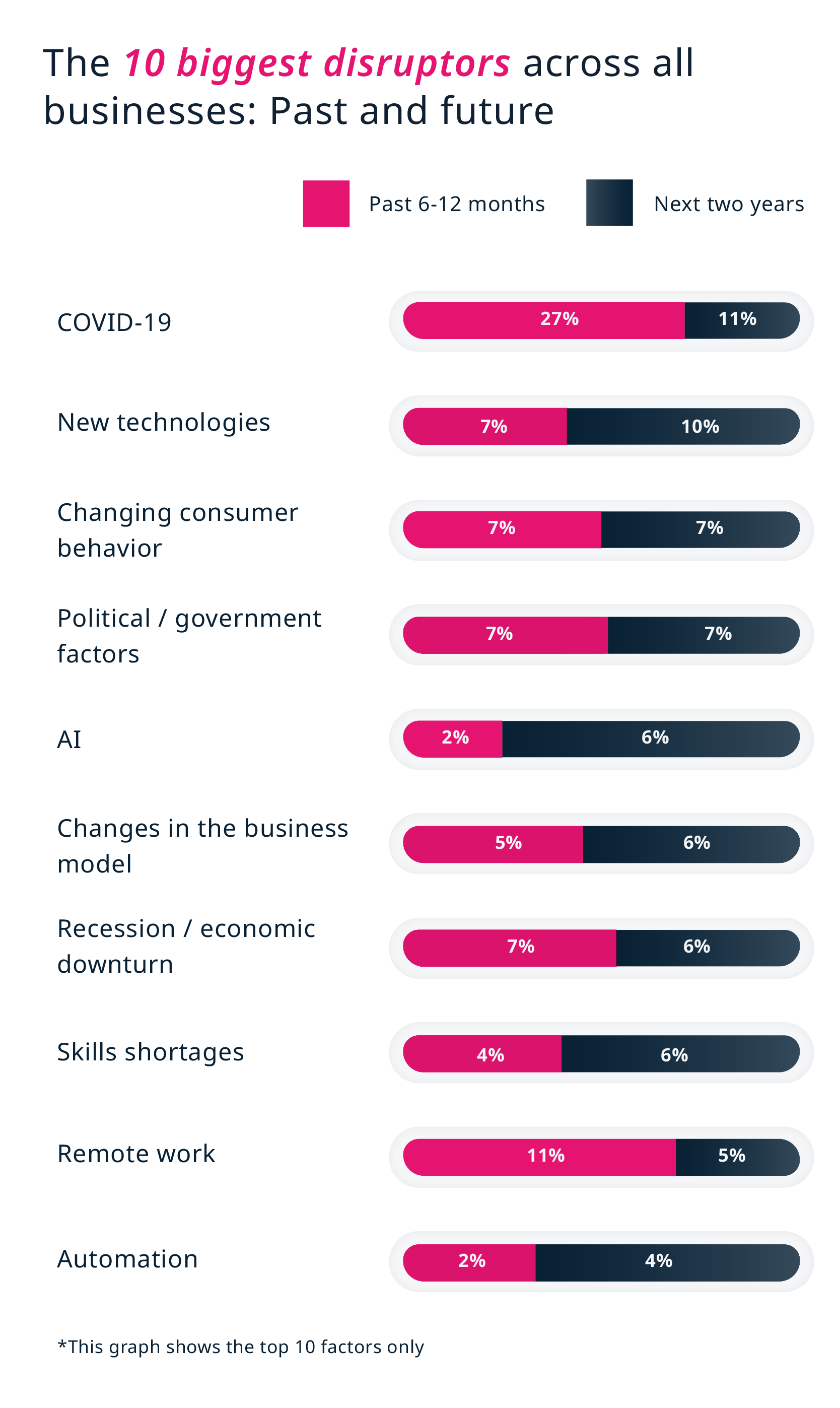
To understand why we need digital transformation is also to define exactly what it is. The research uncovers 19 different interpretations instead of one accepted standard, emphasizing a lack of shared understanding. To add to this uncertainty, it reveals that digital transformation also regularly gets confused with digitization and digitalization. Digital transformation goes beyond these single processes.8 It’s an integrated approach that leverages advanced technologies while harnessing human capital through change management to make business better – for employees and customers.
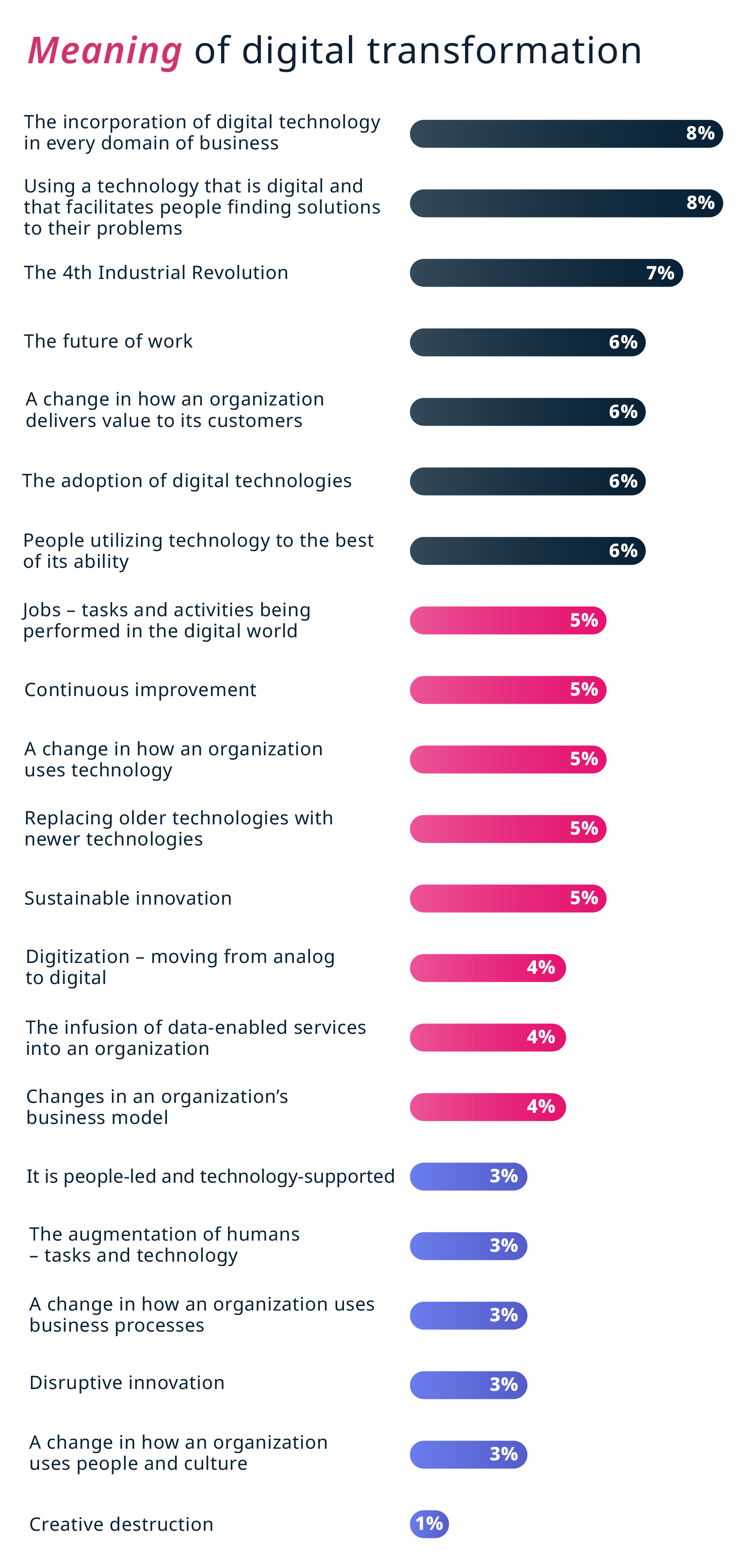
Companies that are effectively transforming digitally earn plenty of benefits. More than 75% of transformation initiatives yielded cost reductions and improved the employee experience. Additionally, two-thirds of respondents said that the efforts increased revenue from both existing and new revenue streams.9
The GetSmarter research shows that this isn’t restricted to business benefits. By adopting a digital transformation within job roles and careers, success is future-proofed across all three areas.
What technologies, processes, and management are needed?
There is no one-size-fits-all solution: businesses require a unique change management plan that’s founded on a long-term view and a shared vision.
From the professionals surveyed in the GetSmarter research, 35% believe digital transformation is a people-centric change, and 32% think it’s a tech-driven change. The truth lies in the middle, as a successful digital transformation requires both, and needs to be integrated into a customized, integrated change management strategy. This should be founded on a long-term view of a company’s role in the digital future within its specific industry. Then short-term ‘stepping stones’ are added, which are rooted in realistic management timelines.10
The GetSmarter survey results show the pressure of transformation is felt the most in terms of integration into systems and processes, strategy and leadership, and data collection and analysis. These need to be key areas of focus when undergoing change and transformation.
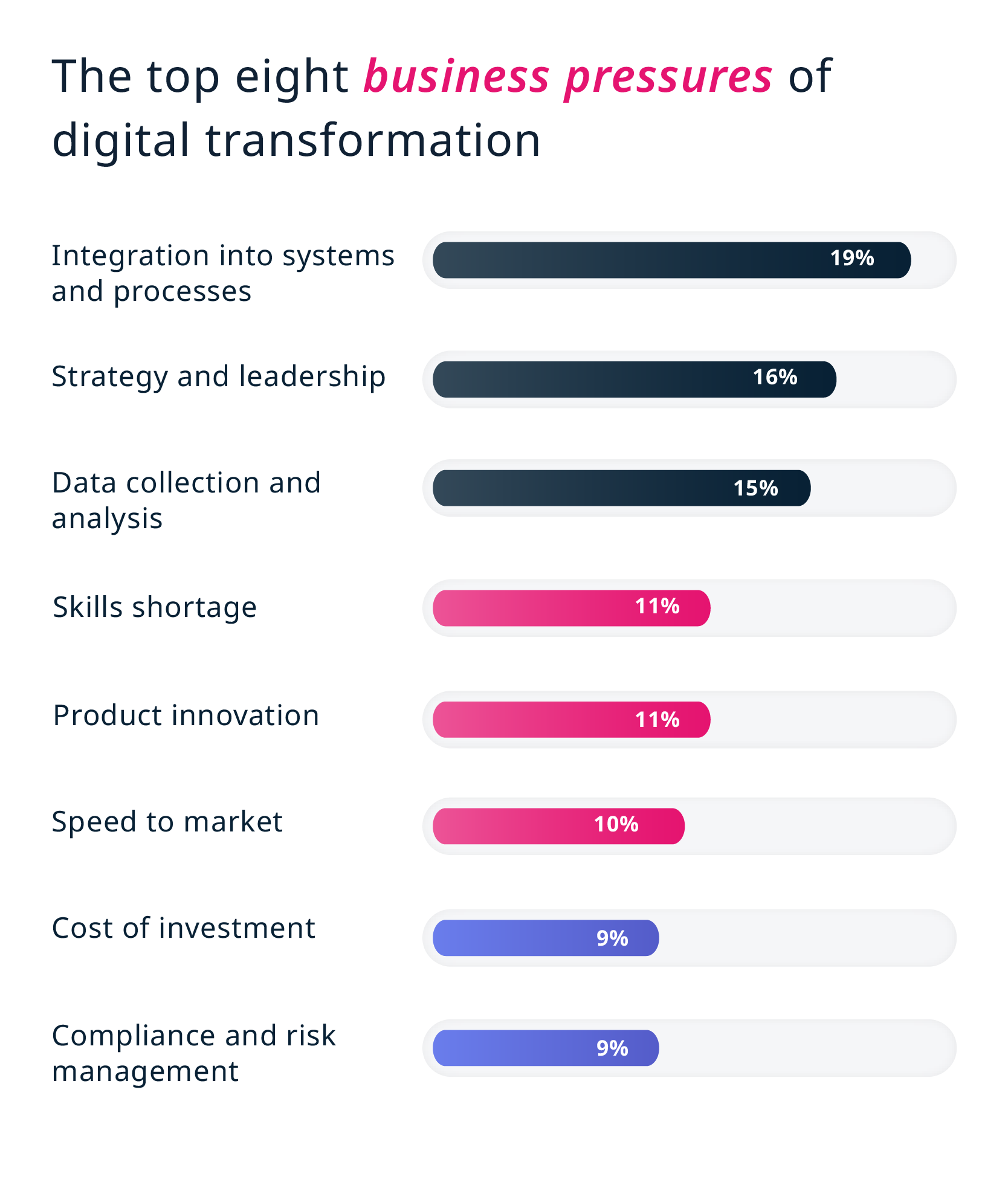
Your digital transformation strategy needs to educate, align, and motivate employees with a unique vision of success – this is going to be different for every business. It starts with defining clear objectives and your management plan before any investment takes place.11 Less digitally mature companies tend to focus on specific technologies and use them to improve general operations, while more mature organizations create digital strategies with the intention of transforming their business entirely.12
Before technologies, processes, and management can be decided, you’ll need to ask yourself what you want to achieve through technology and transformation. Your answer will dictate what tech you implement, the ways you do it, and who manages it.
Who is responsible for digital transformation?
This is where the success of digital transformation is decided. A few key employees will be responsible for carrying out the plans, but all employees need to be aligned, motivated, and ready to contribute meaningfully.
In GetSmarter’s survey, 35% of respondents said they’re uncomfortable with changes that have occurred recently, but most are not resistant when it comes to change. This implies that employees accept that change is inevitable and a part of work, but may be struggling to implement and transition. Change management is built to address these transformation obstacles.
A change management program focused on tackling these human barriers needs to be run in parallel to any digital transformation program – from the very beginning. Organizations need to respond uniquely to each employee’s level of resistance to change as digital transformation affects each individual differently.
Digital transformation requires authentic buy-in from all employees and a concerted effort to break down the resistance to change through a shift in attitudes and skill sets. You need a culture of innovation, and that’s where change management can shine. Its goal is to create confident, positive, and prepared stakeholders with the skills and commitment to ensure new initiatives succeed.13
While the involvement of the CEO and other top leadership figures is vital in creating a vision for the company and scaling effectively, a solely top-down strategy is less likely to drive sustainable change.14 For this to work, it has to be a joint effort that’s championed by several key decision makers across the whole organization, from the CEO and chief digital officer through to human resources and staff within each department.
Organizations that seek transformation frequently recruit outside consultants who tend to apply one-size-fits-all solutions in the name of ‘best practice’. A better option is to rely instead on your own people – skilled staff who have intimate knowledge about what works and what doesn’t in their daily operations. Assembling the right team of technology, data, and process people who can work together – with a leadership team who can bring about change – may be the single most important step that a company contemplating digital transformation can take.15
Success requires strong leadership. The GetSmarter survey results show that the three skills that’ll have the greatest positive change in usefulness in the next three years are strategic planning, cultural intelligence, and change management. Leaders have to prioritize their ability to plan strategically for the future, as well as their ability to embrace diversity and navigate uncertainty.
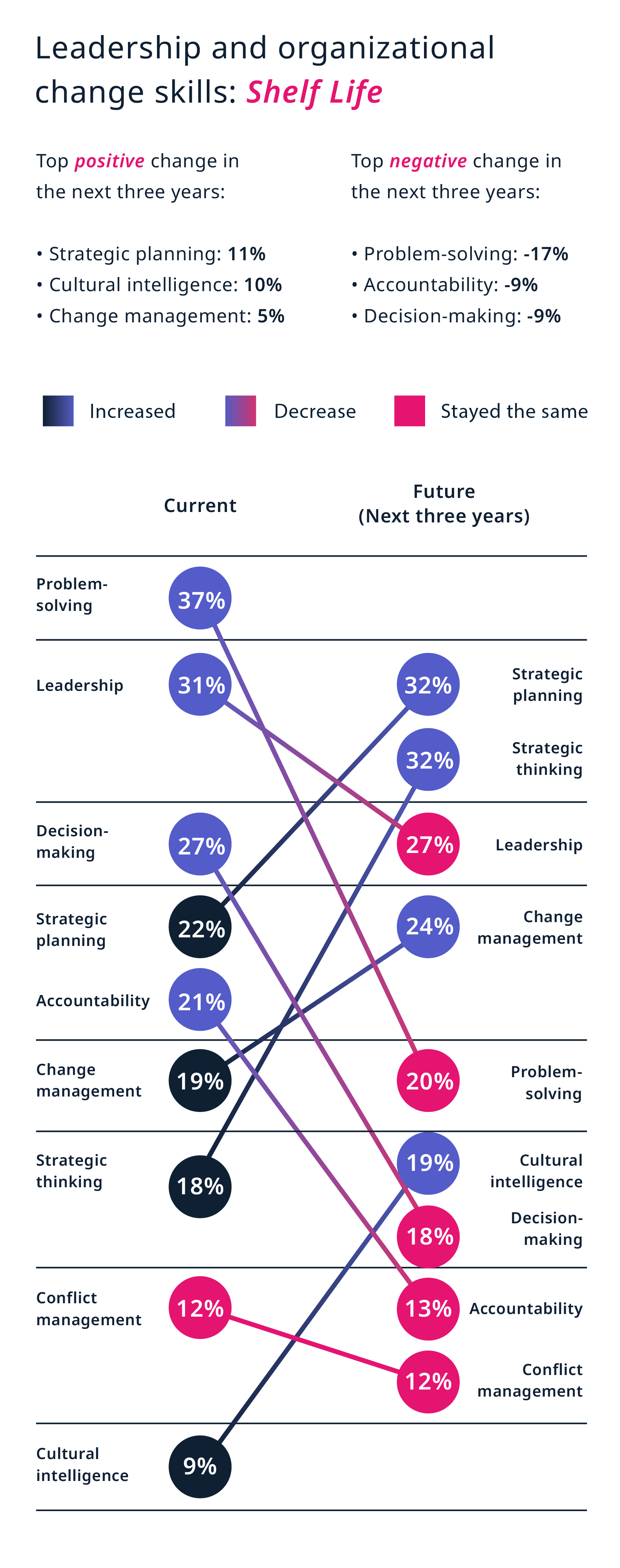
When will the changes take place?
The timing of change depends on the unique demands of your digital transformation strategy. First, your team will need to analyze your business needs and to define your objectives. Start with your end goals, then develop the sequence of steps best suited to achieving them. Digital transformation should be focused on problems of greatest need to the company, and those priorities will inform the talent (and resources) required.16
To help further define your strategy, you need to understand where your industry is heading and what the biggest challenges to digital transformation are, and then to ask yourself the following questions:17
- Why are you investing in digital transformation?
- What is your priority?
- How will you measure success?
- What is your starting point?
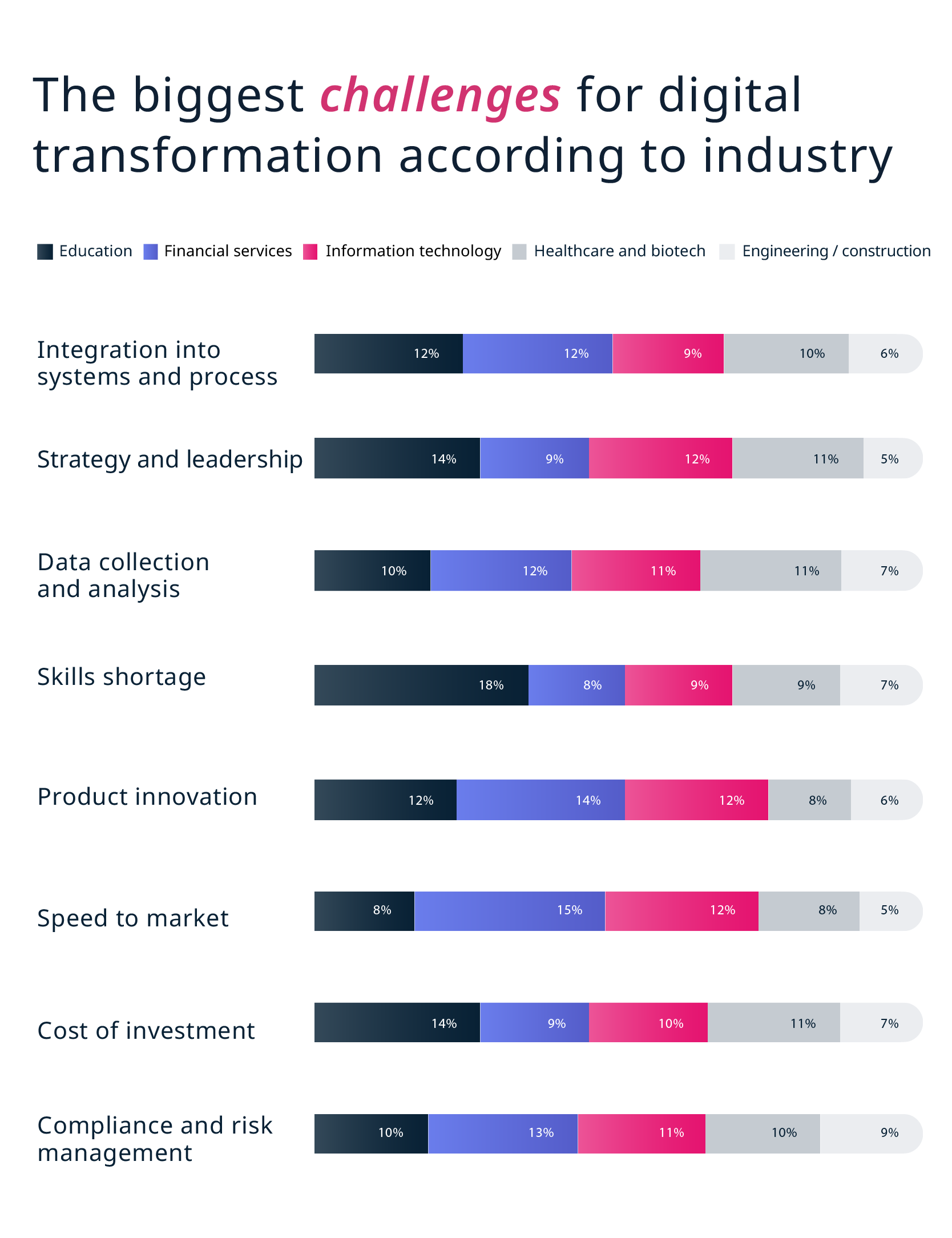
From there, it’s up to leadership to create a coherent digital transformation strategy with long-term goals and short-term milestones. Technology is advancing at an ever-faster pace, and it means there is no real finish line: this requires more agility and adaptation on behalf of everyone.18
Once you’ve outlined your digital transformation strategy, there are three main stages in implementation:19
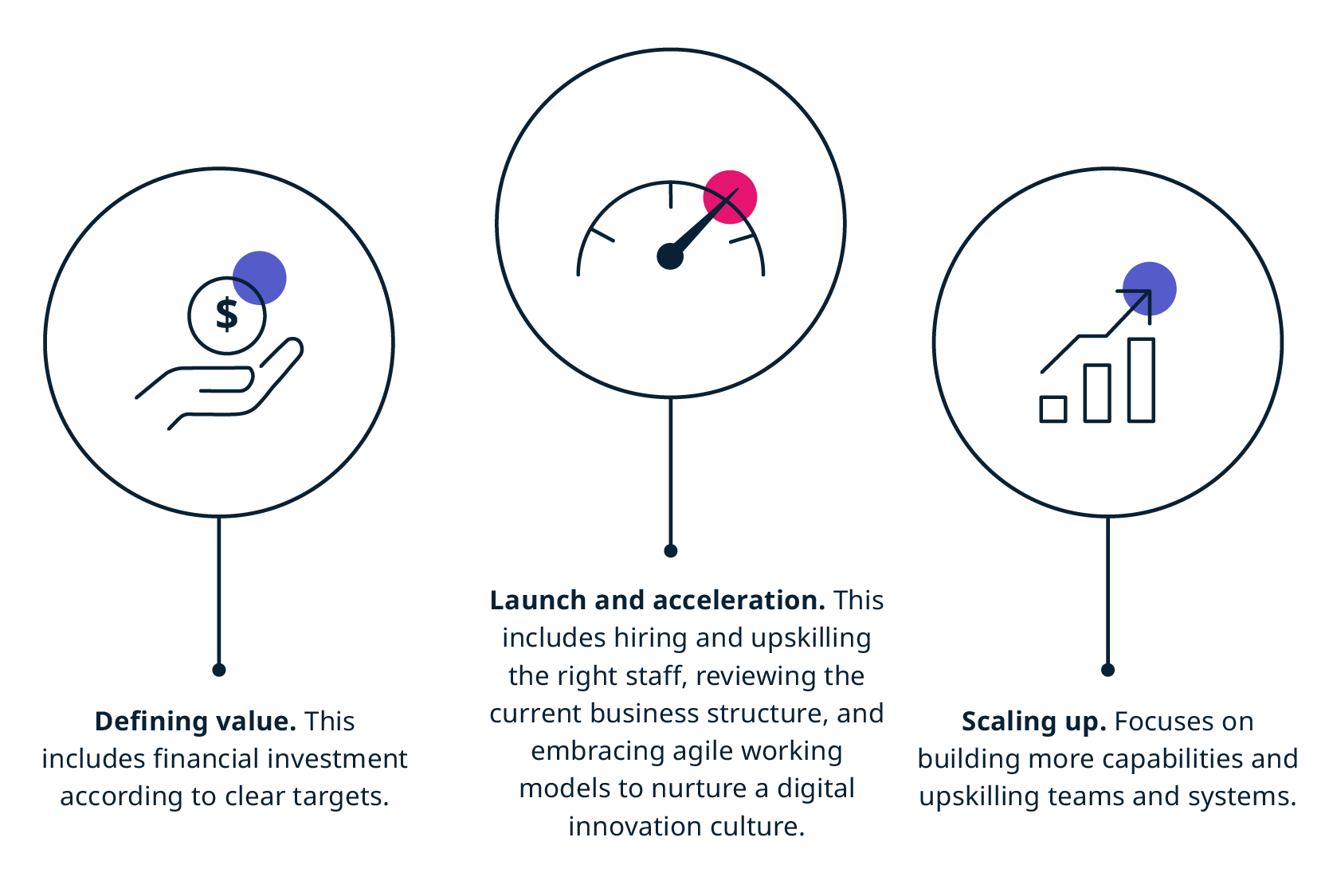
Where will the changes occur?
Ideally, they should occur in every department, but the proportion of change across your business will depend on the business needs and strategy you defined from the previous step. Digital transformation involves rethinking how an organization uses technology and how these technologies interact with processes across every area of the business. Success requires bringing together and coordinating a great range of effort. It calls for vision, roadmaps, process development, training, trial and error, and enormous amounts of time and energy.20 Leaders have to effectively convey the need for change and explain to all employees where and how it’ll impact the workplace. It’s only when the strategy, employees, and digital tools are fully aligned that the full potential of the transformation can be unlocked.
Our world is transforming at a faster pace than ever before, and leaders need to dial in their companies digitally to future-proof their organization’s success, along with their careers. Digital transformation plans can revolutionize the way you do business and your skill set, but it requires bespoke change management plans and smart upskilling. By taking this digital leap, you can unlock benefits for your business, career, employees and, of course, your customers.
Learn how to transform both your business and your career by taking a deeper dive into GetSmarter’s latest digital transformation research.
- 1 (Nov, 2021). ‘Change Management: What it is and why it’s important.’ Retrieved from indeed.
- 2 (Nd). ‘Managing organizational change’. Retrieved from Gartner. Accessed 28 April 2022.
- 3 (Nd). ‘What is digital transformation?’. Retrieved from Salesforce. Accessed 28 April 2022.
- 4 (Nov, 2021). ‘New IDC spending guide shows continued growth for digital transformation as organizations focus on strategic priorities’. Retrieved from IDC.
- 5 (May, 2021). ‘68% of enterprises fail to achieve desired ROI on digital transformation, and most cite change resistance as key obstacle | Press release’. Retrieved from Everest Group.
- 6 Quinlan, L. et al. (Jan, 2022). ‘Strategies of change’. Retrieved from BCG.
- 7 (Nd). ‘The benefits of digital transformation’. Retrieved from Thales. Accessed 28 April 2022.
- 8 Mistry, M. (Nov, 2021). ‘Three concepts to embrace for effective digitally driven innovation’. Retrieved from CIO.
- 9 Dhasarathy, A. et al. (Mar, 2021). ‘Seven lessons on how technology transformations can deliver value’. Retrieved from McKinsey Digital.
- 10 (Apr, 2022). ‘How to build digital into your business strategy’. Retrieved from GetSmarter.
- 11 Mueller, B. (Apr, 2022). ‘How to map out your digital transformation’. Retrieved from Harvard Business Review.
- 12 Gurumurthy, R., et al. (Apr, 2021). ‘Putting digital at the heart of strategy’. Retrieved from Deloitte.
- 13 Hollister, R. et al. (Aug, 2021). ‘Why every executive should be focusing on culture change now’. Retrieved from MIT Sloan Management Review.
- 14 London, L. et al. (Sep, 2021). ‘How many people are really needed in a transformation?’. Retrieved from McKinsey.
- 15 Walters, A. (Jul, 2021). ‘How to navigate the people side of digital transformation’. Retrieved from EY.
- 16 Arbeeny, S. (Nov, 2021). ‘Why digital transformation must start with a clear, defined mission statement’. Retrieved from Forbes.
- 17 (Nd). ‘9 Critical success factors needed for successful digital transformation’. Retrieved from HSO. Accessed 28 April 2022.
- 18 Misra, S. (Sep, 2021). ‘Why successful digital transformation requires speed and agility over a long period of time’. Retrieved from IncAfrica.
- 19 (Apr, 2022). ‘How to build digital into your business strategy’. Retrieved from GetSmarter.
- 20 (Sep, 2021). Digital transformation spending is up to $700B per year, but results lag’. Retrieved from VentureBeat.